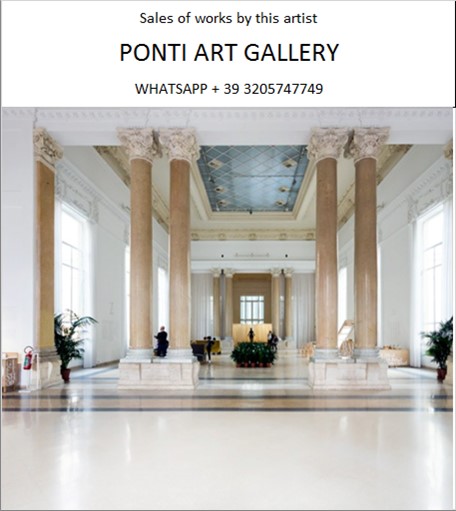Ponti Art Gallery is interested in buying and selling works
of art by this artist.

Ray Man Biography
Man Ray, born Emmanuel Radnitzky on August 27, 1890, in Philadelphia, Pennsylvania, was a multifaceted and influential artist who played a significant role in the Dada and Surrealist movements. His work spanned various mediums, including photography, painting, sculpture, film, and printmaking, and his innovative approach left a lasting imprint on the art world.
The eldest son of Russian-Jewish immigrants, Man Ray grew up in a creative environment in Brooklyn, New York, where his family had moved in 1897. His father worked as a tailor, and his mother was a skilled seamstress, which may have influenced Man Ray's later work that often included sewing motifs. Despite his family's artisanal background, Man Ray was drawn to the arts from a young age. He showed an early talent for drawing and painting and was encouraged by his parents to pursue his passion.
Man Ray's formal education in the arts began at the Boys' High School in Brooklyn, where he received a grounding in drafting and other technical aspects of art. He continued his studies at the Ferrer School in New York, where he was exposed to modernist ideas and avant-garde art. It was during this time that he adopted the pseudonym Man Ray, a name that reflected his desire for a new identity that was both personal and universal, much like his art.
In 1915, Man Ray's artistic career took a significant turn when he met the French artist Marcel Duchamp. The two formed a close friendship and collaboration, which led to Man Ray's involvement with the Dada movement. Dada was an anti-art movement that emerged during World War I as a reaction against the traditional values and conventions of the art world. Man Ray embraced Dada's irreverence and its emphasis on chance and spontaneity in the creation of art.
Man Ray's early work in New York included paintings and objects that challenged the boundaries of art. His "ready-mades," everyday objects presented as art, were influenced by Duchamp's similar works. One of his most famous ready-mades is "The Gift" (1921), an iron with tacks glued to its bottom. In 1920, along with Duchamp and Katherine Dreier, he founded the Société Anonyme, an itinerant collection that was effectively the first museum of modern art in the United States.
In 1921, seeking a more receptive audience for his work, Man Ray moved to Paris, which was then the center of the artistic avant-garde. There, he became involved with the Surrealist movement, which sought to release the creative potential of the unconscious mind. Surrealism's emphasis on dream imagery and the irrational resonated with Man Ray's own artistic inclinations.
Man Ray's contributions to photography are particularly noteworthy. He rediscovered the technique of making "cameraless" photographs, which he called "rayographs," by placing objects directly on light-sensitive paper and exposing them to light. This process resulted in enigmatic images that blurred the line between reality and abstraction. His photographic work also included solarization, a technique that partially reverses the tones in photographic images, creating a surreal, dream-like quality.
Throughout the 1920s and '30s, Man Ray was a prominent figure in the Parisian cultural scene. He became a sought-after portrait and fashion photographer, capturing images of the celebrities and artists of the time. His work appeared in magazines such as "Harper's Bazaar," "Vu," and "Vogue." He also continued to experiment with film, creating several influential short films that are considered classics of Surrealist cinema.
During World War II, Man Ray was forced to leave Paris and moved to Los Angeles, where he continued his work in photography and painting. In 1946, he married Juliet Browner, a dancer and model, in a double ceremony with their friends Max Ernst and Dorothea Tanning. Despite his success in Hollywood, Man Ray longed to return to Paris, which he did in 1951.
Man Ray continued to create art until his death on November 18, 1976, in Paris. His legacy is that of a pioneer who defied categorization, constantly pushing the boundaries of what art could be. His work has inspired generations of artists and continues to be celebrated in exhibitions around the world. Man Ray's influence can be seen in the works of numerous modern and contemporary artists, and his contributions to photography and the avant-garde movements of the early 20th century remain unparalleled.
Ray Man Quotes and Sales of
Works
Ponti Art Gallery selects and deals with paintings by the
artist. Upon request, we provide free estimates and
evaluations, communicate prices, quotations, and current
market values.
If you are interested in BUYING or SELLING works by the
artist, contact us immediately.
If you wish to sell or receive an evaluation of the
works:
Send us a frontal photo of the painting, one of the back,
and one of the signature. Also, indicate the dimensions of
the work. Inform us about the purchase origin of the work
and any kind of available documentation (purchase
receipts, certificates of authenticity, publications). One
of our operators will respond to you on the same day. We
guarantee maximum confidentiality and extreme
professionalism.
If you wish to purchase works by the painter: Contact us
and let us know your request. We will inform you about the
available works. We also offer the possibility to
subscribe to our NEWSLETTER, through which you will be
informed at the beginning of each month about the latest
acquisitions of the art gallery.
You can send us pictures of the work:
